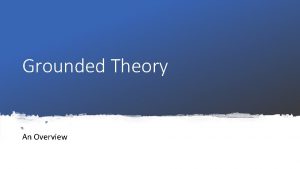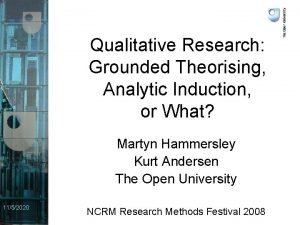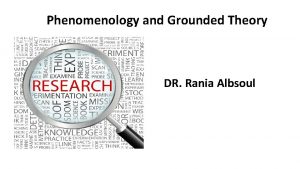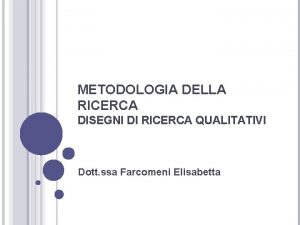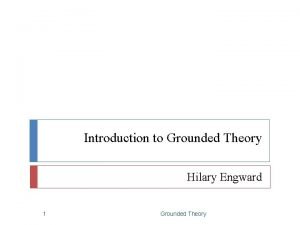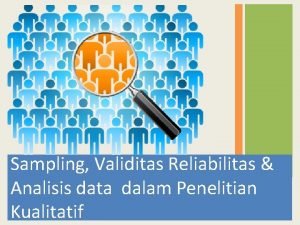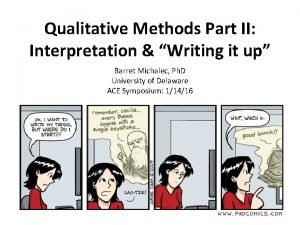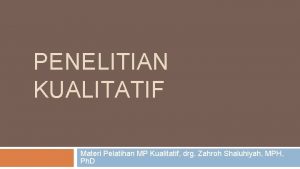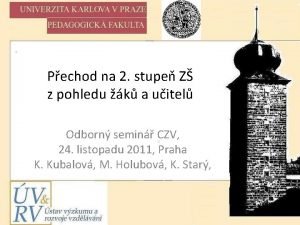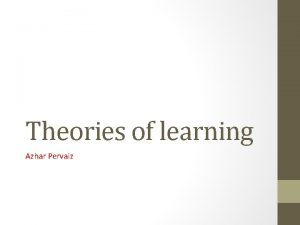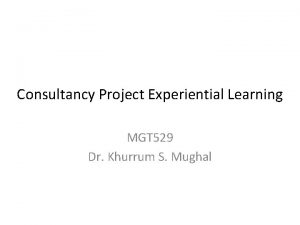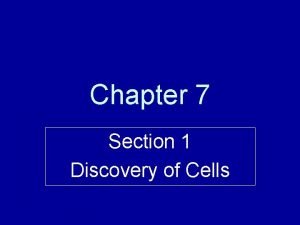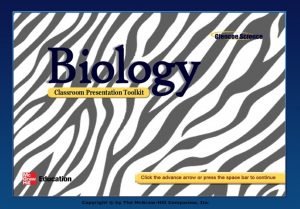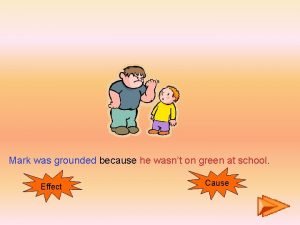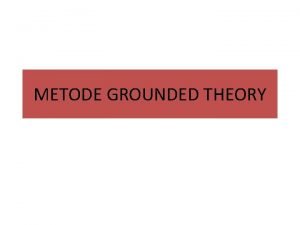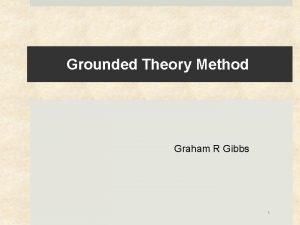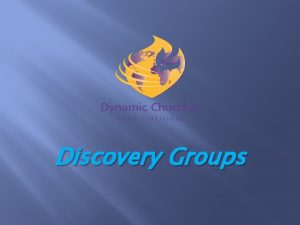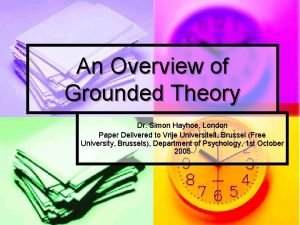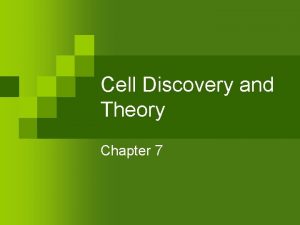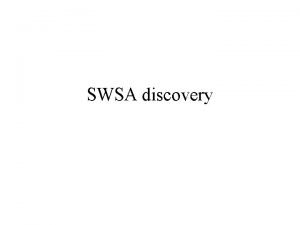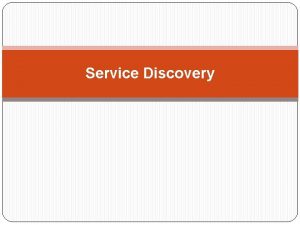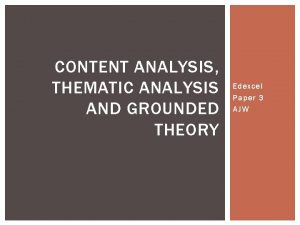Grounded Theory An Overview The Discovery of Grounded









































- Slides: 41

Grounded Theory An Overview

The Discovery of Grounded Theory In 1967 two sociologists, Barney Glazer and Anselm Strauss introduced grounded theory as a systematic, iterative, constant comparative method of data analysis for the purpose of sociological theory construction.

At the Intersection of Disciplines… • Barney Glaser was a highly trained quantitative researcher who studied systematized quantitative inquiry (Paul Lazarsfeld) and the construction of middle range theories (Robert K. Merton) that would explain the structure and functioning of social intuitions and answer empirical questions. • Anselm Strauss studied with at the University of Chicago who had long engaged in field research and viewed the city as a natural setting to pursue research. He was influenced by pragmatism and adopted a sociological branch of it called symbolic interactionism. New knowledge, wisdom, is often discovered at the intersection of disciplines.

Symbolic Interactionism • Views humans as active, free, agents who can interpret and act upon their situations • Takes language and interpretation into account • Treats events as open-ended and emergent • Studies individual and collective action • Acknowledges the significance of temporality. • Truth is mutable or relative…

Pragmatism • The central notion of pragmatism focuses on the nature of truth. In it simplest explanation pragmatism would yield the following: • Truth is found in that works; and • Truth is relative to the current situation. • However simple these statements may be they created some of the most heated and widespread debate concerning the value and “truth” of pragmatism as a philosophy.

Deduction, Induction, and Abduction • The pragmatist tended to see the world as it is. The dichotomy that had formed between the objective world and the subjective world seemed for the most part inconsequential. • The pragmatist found no value in absolute objectivity or absolute subjectivity, seeing neither as sufficient for understanding the nature of reality. • The pragmatist pointed out that the affinity between quantitative methodologies and qualitative methodologies may be more deeply rooted than is commonly thought. • In part this perspective was formed when the pragmatist positioned their philosophy as being value informed.

Ontology… • This philosophical position held by pragmatism yielded an intersubjective rendering of the truth reality where the ontological elements revealed were seen as relational and situational. • The “we” or relationships aspect would hold that truth is co-created by way of intersubjective relationships. • This co-created truth is epistemologically valid because it is co-constructed by the collective experience. It is through this relational construct that the nature of reality, the ontological reality, is revealed.

Deductive Reasoning • Allows deriving b from a only where b is a formal logical consequence of a. • In other words, deduction derives the consequences of the assumed. Given the truth of the assumptions, a valid deduction guarantees the truth of the conclusion. • For example, given that all bachelors are unmarried males, and given that this person is a bachelor, one can deduce that this person is an unmarried male.

Inductive Reasoning • Allows inferring b from a, where b does not follow necessarily from a. a might give us very good reason to accept b, but it does not ensure b. • For example, if all swans that we have observed so far are white, we may induce that the possibility that all swans are white is reasonable. We have good reason to believe the conclusion from the premise, but the truth of the conclusion is not guaranteed. (Indeed, it turns out that some swans are black. )

Abductive reasoning • Allows inferring a as an explanation of b. • A form of logical inference which goes from an observation to a theory which accounts for the observation, ideally seeking to find the simplest and most likely explanation. In abductive reasoning, unlike in deductive reasoning, the premises do not guarantee the conclusion. • One can best understand abductive reasoning as "inference to the best explanation".

Grounded Theory • Focus - developing a theory grounded in the data from the field • Discipline of origin - Sociology • Data collection - interviews with up to 20 -30 individuals to “saturate” categories and detail a theory • Data analysis - open coding, axial coding, selective coding, conditional matrix • Narrative form - Theory generation, theoretical position, or theoretical model.

Grounded Theory In this type of study, the researcher generates an abstract analytical schema of a phenomenon, a theory that explains some action, interaction, or process. This is accomplished primarily through collecting interview data, making multiple visits to the field (theoretical sampling), attempting to develop and interrelate categories (constant comparison) of information, and writing a substantive or contextspecific theory (Strauss and Corbin, 1990).

Constructivist Grounded Theory This development employs the fluidity and openness of Strauss’ approach while incorporating the specific strategies for analyzing data developed by Glaser.

Grounded theory provides a perspective that allows the researcher to view the phenomenon as if through the examination lens of an ophthalmologist. The examiner starts with a standard magnification and refocuses through a sequence of lenses until complete clarity is achieved. This refocusing is accomplished in grounded theory through theoretical sampling, which guides the selection of participants and leads to the discovery of a theory grounded in research data. The number of participants can not be determined in advance. “[T]here are no limits set on the number of the participants, interviewees or data sources” (Cutcliffe, 2000, p. 1477).

Process and Protocols Beginning with the Phenomenon of Interest Theoretical Conditioning: Answers three critical questions; • What is the real issue? • What are the facts as we understand them now? • What is the role of the researcher? This establishes Theoretical Sensitivity.

Theoretical Sensitivity Glaser stated that entering the research with as few predetermined ideas as possible could strengthen theoretical sensitivity. His concern was for the eager theorist interested in finding support for a preexisting hypothesis or belief system. • A radical interpretation of Glaser’s position could create a situation where theorist does nothing to gain a perspective of the ecology under study. Proceeding without theoretical sensitivity, a researcher has no knowledge of fit or relevance of the data collected.

Theoretical Sensitivity Strauss and Corbin (1990) referred to theoretical sensitivity as, “the attribute of having insight, the ability to give meaning to data, the capacity to understand, and the capability to separate the pertinent from that which isn't. ” • They were stressing awareness of the activities within the ecology as it related to the data. They appear to be less concerned with preexisting hypotheses than with lack of insight or knowledge about the ecology. • The choice here is on which side do we error - bias or ignorance?

Gaining Theoretical Sensitivity It is possible to gain theoretical sensitivity through several strategies: • Through participating in the ecology and by doing so becoming part of the environment • By observing the activities within the ecology and reflectively sorting through these observations • By questioning the processes we don't understand within the ecology and by doing so becoming an apprentice to those experts (informants) within the ecology • By using theoretical literature to examine the interpretations of others that may be related to the nature of this ecology.

Process and Protocols • General Sorting: Generating awareness of human ecology under study. • Reflective Sorting: Examining key concepts, phenomena, events, then organizing them according to knowledge of ecology. Describing setting, actors, process, events. Useful for triangulation and verification. • Selective Questioning: Systematically defining area of interest through questioning. Assessing discoveries obtained during reflective and general sorting that lead to developing study purpose and forming the grand tour question. • Research Protocol Development • The pilot protocol is lifted from theoretical conditioning • The formal protocol is developed from pilot procedures

Process and Protocols Mc. Caslin & Carlson

Open Coding • Open coding is an inductive, analytical procedure that performs two basic tasks: it makes comparisons and it asks questions. • For this reason grounded theory is often referred to as the constant comparative method of analysis (Glaser & Strauss, 1967). • Open coding is the systematic process of sorting through the data, categorizing events and concepts by their properties and dimensional range.

Open Coding Glaser recommends the analyst constantly ask three questions: • What is this data a study of? • What category or property of a category, of what part of the emerging theory, does this incident indicate? • What is actually happening in the data? (p. 57).

Reflective (Axial) Coding • Comparing categories generated through open coding towards generating an understanding of the ecology. Open coding fractures the data—axial/reflective coding determines their source and uncovers their properties, processes, dimensions, context and strategies for understanding their consequences as related to ecology. • That depth of reflective coding is directly informed by the researcher’s experience with the phenomenon of interest and appropriateness or “fit” of theoretical sensitivity achieved. • For that reason I refer to axial coding as reflective coding. Corbin and Strauss, (1990) recognized that open and reflective coding are distinct analytic procedures. However, they concur that in coding a researcher will alternate between the two modes. Let’s explore that reality a bit more.

The Conditional Relationship Guide is formatted to ask and answer the relational questions about the emerging code category. • What is [the code category]? (Using an informant’s words helps avoid bias. ) • When does [the code category] occur? (Using “during…” helps form the answer. ) • Where does [the code category] occur? (Using “in…” helps form the answer. ) • Why does [the code category] occur? (Using “because…” helps form the answer. ) • How does [the code category] occur? (Using “by…” helps form the answer. ) • With what Consequence does [the code category] occur or is [the category] understood?

Category What When Where Ability to Adapt Shifting Perception to discover & implement new alternatives During times of In informant’s Adversity, often, Background, in when Age Factor Steps of Pursuit is an issue, dealing with the Negativity of others Adversity Obstacles, illness, Throughout life, injury, rejection of Pursuit others, negativity, lack of resources, & fundamental to growth In Background, in Steps of Pursuit Age Factor In late life, age affects view of ability, not limiting if have health, provides sense of urgency Mid- to late-life (56 – 70 in this study) Extraordinary Involvement in Pursuits Background Expressed areas of Informants’ history & philosophy Throughout life Venues of life & Pursuit Why How Consequence Obstacles Part of Process, Business as Usual, Nothing Personal, & Others Affect Pursuit Shift Perception, Open to Possibility, Open to Learning from Any Source, Risk, Must be a Way, Focus on What’s Important, Do Those Things I Can Control Choice Others Affect Pursuit, Risk, Age Factor; Obstacles Part of Process; Business as Usual, Nothing Personal Physical/Health Limitations, Others Affect Pursuit Perceptions of: Negativity, Lack of Knowledge, Differences Between US & Other Countries Perception Belief Influences of: Others Affect Pursuit, Support & Belief of Others, Coach/Mentors In sailing, age Perception diminishes endurance, in racing ill health & slower recovery from injury diminish strength, expressions of agerelated Negativity in writing, music, research Belief & Self. Belief/Efficacy

The Reflective Coding Matrix • A tool used to bridge reflective coding and selective coding or interpretation. • Useful in isolating, then defining the core category by its linkages to properties, processes, dimensions, context, and for understanding the consequences.

Reflective Coding Matrix example

Definition of Key Terms Category: This is the unit of information analyzed in grounded theory research (Creswell, 2007, p. 237). They are concepts the stand for phenomena (Strauss and Corbin, 1998, p. 101). General (or open categories) are revealed through the hortizontalization of the data in open coding procedures. Code categories are the generalization of these open codes through axial or reflective coding. Core Category (sometimes referred to as the central phenomenon): This is the overarching category that begins to reveal the emerging theory. It is the final collapse of data into a theoretical position. It leads to the format statement of theory that is supported by the data from which it emerged. Properties: Characteristics of a category; the delineation of which defines and gives it meaning (Strauss and Corbin, 1998, p. 101). Properties are attributes of a category that appear during open coding.

Definition of Key Terms • Process: Is the pragmatic understanding of the emerging theory that is revealed through the conditional relationship guide. It reveals the dynamic aspects of the emerging theory and aids in interrelating the various properties to the core category. • Dimensional Range: the range along which general properties of a category vary; giving specification to a category and variation to theory. (Strauss and Corbin, 1998, p. 101). • Context: This is the reveal concerning where and how the emerging theory fits and/or relates with or to the ecology from which it was discovered. • Strategies for Understanding the Consequences of the Emerging Theory: This is the preliminary statement of the emerging theory. It is a verifying process that examines the emergent theory for fit and relevance to the human ecology. Checks for credibility, transferability, and dependability of emergent theory.

Selective Coding According to Strauss and Corbin (1990) selective coding (interpretation) is the process of selecting the core category, systematically relating it to other categories, validating those relationships, and filling in categories that need further refinement and development.

• Gain theoretical sensitivity in both the ecology & in the literature • Informants: purposeful theoretical sampling, selected for criteria. Constructivist Grounded Theory • Analysis is iterative, & alternately inductive & deductive, weaving from one coding phase to the next. • Open coding is very detailed, separating each strand of data from the rest • Reflective coding begins weaving the strands together • Step back - what’s happening here? • Selective coding is the Interpretation Phase • Tools I devised led me to the story line • Story line led to the emergence of theoretical position

Ecology Observations Interviews Constructivist Grounded Theory: (Mc. Caslin/Scott) Literature Technical Non-Tech Open Coding Analysis Concepts - Categories - Properties & Dimensions What’s happening? Reflective Coding Analysis Reassemble New Way - Link Categories & Dimensions Conditional Relationship Guide & Reflective Coding Matrix Selective Coding/Interpretation Validate Relationships - Discover Patterns Develop Story Line & Theoretical Position Grounding the Theory Crystallize: Data, Literature, Informants in Ecology

Example of Open Coding Analysis 1908 Categories Age Limitations in Biking Unknown Age Limitations in Writing Unknown Age Limitations in Pursuit Unknown Age Limiting in Solo Voyage Age Limits Choices Age Perspective Age Illusion Age Affects View of Ability Age Affects Ability to Learn Age Benefit Age Increases Challenge Age Impediment Age Affecting Ability Age & Adversity Age & Impetus to Decide Age Motivator Age Perception Age Limiting Factor Age Factor 54 Categories

Reflective Coding Matrix Logic Flow Mc. Caslin & Carlson

Reflective Coding Analysis Conditional Relationship Guide: 54 Categories What? When? Where? Why? How? Consequence? Reflective Coding Matrix

Reflective coding matrix for defining conditions and dimensions of “Commitment to Extraordinary Involvement. ” Reflective Coding Matrix Core Category Commitment to Extraordinary Involvement Properties Process Position Perception Product Purpose Process Choice Conviction Belief Achievement Development Dimensions Context Modes for Understanding Consequences Ability to Adapt Focus on What’s Important Must be a Way Obstacles Part of Process Follow Threads of Inspiration Epiphany Sense of Autonomy Risk Negativity Age Factor Sense of Urgency Adversity Faith Open to Possibility Who I am Success Achievement Plan Keep Moving Forward Pursuit Evolved Learning the Craft Personal Expression Sense of Self-Worth Communicating Perspective Compelling Passion Creative Energy Challenge Personal Criteria Identity Personal Goal Meaning in Goal Momentum in a Direction Sacrificing Ordinary for Extraordinary Self-Efficacy Progressive Realization of Worthwhile Goals Maximizing Personal Potential Creates Positive Energy

Example of a Conditional Matrix (Graphic format) Inner Voice e ht g i , ce oi les Ch stac of t Ob ar ess P oc Pr Personal Criteria Congruous Autonomy Posi tive Forc e Ach iev t in emen S t eps Follo Inspir w at Conv ion, iction R s s ne Positive Force f, lie ty, Be nti e f Id el acy S fic Ef it r C , ria Epiph Risk/S any: acri Urgen fice cy t, en m op ing l ve ean e D M

Conditional Matrix Textual (example)

Example 2 (from same study as above) Graphical Conditional Matrix

Process and Protocols Mc. Caslin & Carlson

Constructivist Grounded Theory with the additional of Meta. Interpretation (Cont. ) Note: Stage 4 and on is Glaser and Strauss’s original Model (1967) Mc. Caslin & Carlson
 The discovery of grounded theory
The discovery of grounded theory Benefits of grounded theory
Benefits of grounded theory What is grounded theory in simple terms
What is grounded theory in simple terms Analytic induction qualitative research
Analytic induction qualitative research Phenomenology vs grounded theory
Phenomenology vs grounded theory Disegno di ricerca qualitativa esempio
Disegno di ricerca qualitativa esempio Advantages of grounded theory
Advantages of grounded theory Grounded theory research ppt
Grounded theory research ppt Example of quantitative research
Example of quantitative research Holistic perspective qualitative research
Holistic perspective qualitative research Kathy charmaz
Kathy charmaz Validitas data kualitatif
Validitas data kualitatif Qualiative research
Qualiative research Grounded theory research
Grounded theory research Grounded theory adalah
Grounded theory adalah Grounded theory
Grounded theory Chapter 7 section 4 cellular transport
Chapter 7 section 4 cellular transport Discovery learning theory
Discovery learning theory Discovery learning theory
Discovery learning theory Chapter 7 section 1 cell discovery and theory
Chapter 7 section 1 cell discovery and theory Section 1 cell discovery and theory
Section 1 cell discovery and theory Section 1 cell discovery and theory
Section 1 cell discovery and theory Corner grounded delta
Corner grounded delta Grounded conductor color
Grounded conductor color Map of grounded
Map of grounded Congratulations you got grounded
Congratulations you got grounded Slime mold grounded
Slime mold grounded Hình ảnh bộ gõ cơ thể búng tay
Hình ảnh bộ gõ cơ thể búng tay Frameset trong html5
Frameset trong html5 Bổ thể
Bổ thể Tỉ lệ cơ thể trẻ em
Tỉ lệ cơ thể trẻ em Voi kéo gỗ như thế nào
Voi kéo gỗ như thế nào Tư thế worm breton
Tư thế worm breton Chúa yêu trần thế
Chúa yêu trần thế Các môn thể thao bắt đầu bằng từ đua
Các môn thể thao bắt đầu bằng từ đua Thế nào là hệ số cao nhất
Thế nào là hệ số cao nhất Các châu lục và đại dương trên thế giới
Các châu lục và đại dương trên thế giới Công thức tính độ biến thiên đông lượng
Công thức tính độ biến thiên đông lượng Trời xanh đây là của chúng ta thể thơ
Trời xanh đây là của chúng ta thể thơ Mật thư anh em như thể tay chân
Mật thư anh em như thể tay chân 101012 bằng
101012 bằng Phản ứng thế ankan
Phản ứng thế ankan
